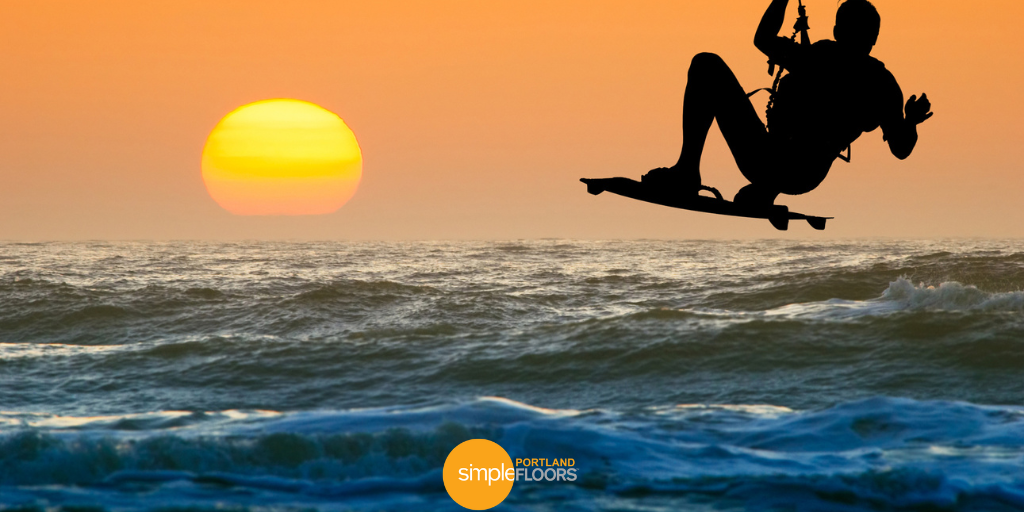Your intrepid blogger was visiting Utah and met another Portlandian who loves kitesurfing by the Columbia river gorge. If you haven’t tried this yet, I’ll have all the details for you to find kiteboarding lessons, and the differences between kitesurfing, kiteboarding, and windsurfing.
What is Kitesurfing?
Kitesurfing uses a large kite and a board to move across the water. Kiteboarding, windsurfing, and kite surfing are all the same, except that kitesurfing uses a directional board to ride waves, and kiteboarding uses a twin tip board to ride on open water.
Windsurfing has a sail attached to a surfboard and is more like sailing since the sail is attached to the board. Windsurfing can be done on just about any body of water where wind is available. There are large and small boards and sails for different wind conditions and levels of experience.
Is Kite Surfing Easy?
To become skilled at harnessing windpower with a board, you need to have excellent coordination and balance. With proper lessons, it can take a few days to a few weeks to get the basics mastered.
The difficult part is combining kite flying and board riding at the same time. However, it’s easier to learn to do basic tricks and jumps with kitesurfing than windsurfing. Windsurfing is easier to get started with, but takes longer to develop.
Some people liken windsurfing to skiing and kite surfing to snowboarding.
And no matter which you pick first, they are not the kind of sport you can go out and pick up without some guidance.
What Equipment do you Need to Kiteboard?
If you’re interested in windsurfing, you will need a board with a sail, mast, and a boom. The sail is a triangular sail like what a sailboat would have. The mast and boom hold the sail out and allow you to move the sail to catch the wind.
Kitesurfing and kiteboarding both use a kite. It can come in three different shapes.
- Bow – the easiest to be pulled down quickly and easiest to use for beginners. They’re also easy to quickly relaunch from the water.
- C – the kite for the pro’s. You can do a lot of quick turns, but it’s a small wind range and difficult to relaunch.
- Hybrid – are also called Delta kites. They’re easy to get up or down from the water and provide some of the nimbleness of the C.
The kites tend to range from 5m2 to 15m2. If there’s low wind, you’ll want a larger kite. And if it’s heavy wind, you’ll want the smaller sizes. Most people who love this hobby have two kites to choose from, depending on the day.
Kiteboarding usually uses a twin-tip board. That’s a board that has the same shaping on both sides to allow you to ride both ways without turning your board around. They tend to have small fins for shallow water which is useful in some rivers or near the shorelines.
There are many other types of boards that could be used for kitesurfing. Some are better left for more experienced riders to do advanced tricks. In general, longer boards are better for beginners and those who enjoy freeriding. Shorter boards are better for trick riding.
You will also want to look into a harness. There are two types. One that fits around your waist, and one that you sit into. The waist harness allows more freedom of movement. You should try out both and see which you prefer.
And you will want a full wetsuit with booties whether you’re windsurfing, kitesurfing, or kiteboarding. Sorry. It’s just cold up here, and the water doesn’t warm up beyond 50F.
The good news is there are a number of places to rent equipment if you’re wanting to check out the sport.
Is Windsurfing Dangerous?
While there is an element of danger due to the unpredictability of winds and water, kiteboarding only has seven injuries per 1,000 hours of physical activity compared to football (36 injuries per 1,000 hours) and soccer (19 injuries per 1,000 hours).
With lessons, you will learn how to handle getting overpowered by the kite, handling a failed launch or landing, getting caught in the kite lines, and more.
Do you Need Consistent Wind?
It depends on your goal if you’ll need steady wind when kiteboarding. If you want to stay up and surf the water, then you need the wind to be at least 12mph on average.
Experienced riders appreciate gusts of wind to get air for their big jumps, and are comfortable with re-launching their kites no matter what the wind is like.
When is the Best Time to Take Windsurfing Lessons?
For a beginner, the best time to learn is between June and September on the river. Some people feel the best swells come in April-June and September-October. So you will want to learn in the Summer and then master your skills in the Fall.
Can you Kiteboard on a River?
Absolutely! The Hood River is known as the “Windsurfing Capital of the World”. There are a number of kiteboarding schools right along the Hood River. They’ll teach you exactly what you need to know to kite surf on a river. You’ll need to look out for sand bars that connect the Hood River to the Columbia River. Beginners are downwind of this bar, and intermediates tend to be upwind. The pros hang out on the Hood River sandbar.
When you go out on your own, you need to remember to let someone know where you’re going, or bring a buddy and keep an eye out for one another. There are no lifeguards. You will need to be aware of other kite surfers. Monitor yourself, and don’t stay out until you’re past exhaustion.
Above all else, remember that you’re there to have fun. And, if you’re looking for other ways to get outdoors in Oregon, CLICK HERE to see the best camping spots in Oregon. Or, to learn more about kitesurfing, watch the video below:









